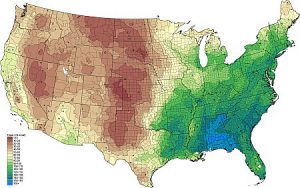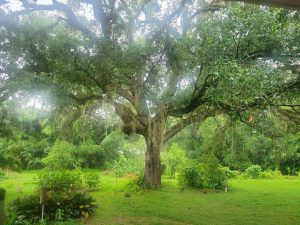Spending time outdoors during the Florida summer is not for the faint of heart. It’s hot! And it’s humid! Just moving around outside for a moment in the early morning causes you to break out in a sweat. Most evenings, even after the sun is low in the western sky, but there’s still enough light to enjoy the outdoors, the sweat doesn’t stop. A Floridian’s only hope is that nearby, there is a large shade tree to take cover under. In north Florida, there’s nothing more inviting than a huge live oak draped in Spanish moss for a drink of ice water and a slight breeze. If you don’t have such a spot, start thinking about planting a shade tree this winter!
In north Florida, we have many options to choose from, as we live in an area of the United States with some of the highest native tree abundance. Making sure you get the right tree for the right place is important so make a plan. Where could this tree go? Is there plenty of space between the tree and any structures? You’ll want to give a nice shade tree plenty of room – 20’ to 60’ away from structures and/or from other large trees – to grow into a great specimen. Be sure not to place a large tree under powerlines or on top of underground infrastructure. You can “Call 811 before you dig” to help figure that out. If space is limited, you may want to consider trees that have been shown to be more resilient to tropical weather. Also try and place the tree in a way that provides added shade to your home. Deciduous trees planted along your home’s southeast to southwest exposure provide shade during the summer and let in the sun during the cooler winter. However, be careful that the tree doesn’t grow to block the sun from your vegetable garden!

A density gradient map of native trees in the US. Notice where the highest number occur. Credit: Biota of North America Program.
Here are some ideas for shade trees, those trees that are tall (mature height greater than 50’) and cast a lot of shade (mature spread greater than 30’). All of these are native trees, which have the added benefit of providing food and shelter to native wildlife.
- Red maple (Acer rubrum)
- Pignut hickory (Carya glabra)
- Green ash (Fraxinus pennsylvanica)
- Tulip poplar (Liriodendron tulipifera)
- Southern magnolia (Magnolia grandiflora)
- Sycamore (Platanus occidentalis)
- Shumard oak (Quercus shumardii)
- Live oak (Quercus virginiana)
- American elm (Ulmus americana)
It’s best to plant during the winter and follow good planting practices.
While it may take a while for you to relax under the shade of your tree, they can surprise you in their growth and, as they say, there’s no time like the present. If you have questions on selecting or planting shade trees, contact your local UF/IFAS Extension office.
- Let Extension Diagnose Your Landscape Issues - May 28, 2025
- No Mow March 2025! - February 27, 2025
- New Year’s Resolution Ideas for Gardeners - January 16, 2025


